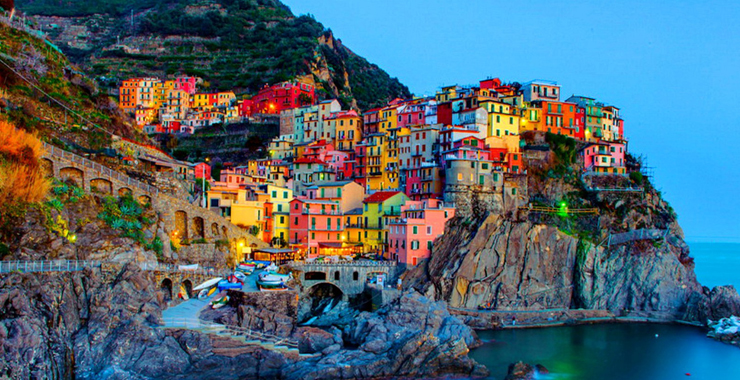 Liguria, also known as the Italian Riviera, consists of two parts: Narrow, the economically developed coastal strip and the mountainous rest of the region, where the inhabitants of villages practically isolated from the world grow olives and vines on terraced slopes. Coming from Nice and Monaco, immediately after crossing the border, an unexpected change is noticed. The Italian Riviera has a more diverse landscape and architecture than the Côte d'Azur in France and is generally less busy, although in the summer it can also be very crowded here. The A12 motorway and the main railway line run side by side along the entire length of the province, and in the intervals between the tunnels, more summer resorts are still appearing, silvery olive orchards and intense blue sea.
Liguria, also known as the Italian Riviera, consists of two parts: Narrow, the economically developed coastal strip and the mountainous rest of the region, where the inhabitants of villages practically isolated from the world grow olives and vines on terraced slopes. Coming from Nice and Monaco, immediately after crossing the border, an unexpected change is noticed. The Italian Riviera has a more diverse landscape and architecture than the Côte d'Azur in France and is generally less busy, although in the summer it can also be very crowded here. The A12 motorway and the main railway line run side by side along the entire length of the province, and in the intervals between the tunnels, more summer resorts are still appearing, silvery olive orchards and intense blue sea.
The main city of the region is Genoa. Heavy industry and crazy traffic make, that the city seems repulsive, but it's worth spending some time in the Old Town located around the port. Genoa divides the coast into two equal parts. Rmera di Ponente in the west is full of Italian families, who book rooms in their favorite hotels a year ahead. Most of this part of the coast, is actually an uninterrupted series of hotels, but there are also places here, which are worth visiting. Noli and Albenga are old medieval towns, Finale Ligure is a very pleasant summer resort, and San Remo, surrounded by built-up greenhouses hills, is an important center of flower breeding, which are sold at the early morning market.
Na Rmera di Levante, in the south-east towards Tuscany, the coast becomes more rugged, and from the slopes almost horizontally grow pines. The evenings here are charming, when blissful peace falls over bays and estuaries. Hiking trails on Monte Portofino and the Cinque Terre lead through macchia and vines, and they come high enough, to give you the opportunity to see a wide panorama of the surrounding bays. This particular landscape of mountains and fishing villages accessible only from the water side suited the tastes of Romantic poets very much., who at the end of the eighteenth century "discovered" the Riviera. After them, other poets and artists came here, and in the first half of our century, the first tourists-holidaymakers in the modern sense of this concept. Currently, every year in July and August, the Riviera is flooded with a crowd of people, who, out of selfishness alone, come to places like Portofino or Santa Margherita Ligure.
A sure way to avoid crowds is to travel deep into the province. The villages are built there spirally around the tops of the hills and connected to each other by narrow roads and paths for mules. (such a system of limited availability was initially intended to defend against Saracen invasions). Along the mountain ridges, from Ventimiglia, located on the French border, through 440 kilometers to Ceparana, north of La Spezia runs Alta Via dei Monti Liguri. In bookstores you can buy a guide to this route published by Centro Studi Unioncamere Liguri, and information about rifugi can be obtained from Club Alpino Italiano offices in major cities. The best bases for tourists and skiers are Monesi, near Monte Saccarello, Alberola, in the mountains near Genoa, and Santo Stefano d'Aveto on the border between Emilia and Romagna. These regions are among those, where renting a car really comes in handy: even though the bus connections of some of these towns to the larger cities on the coast are good, getting to more distant places requires several changes.
With a car you can also get to some of the mountain restaurants more easily, where it is not uncommon to serve Ligurian cuisine in the best possible edition. They are prepared according to the rules, which are basically a way to create something out of nothing. This is the result of a difficult historical legacy, which also results in the characteristic Ligurian reserve. Liguria's difficult past also contributed to the spread among other Italians of an undeserved opinion of the wickedness of the Ligurians..